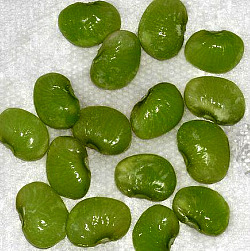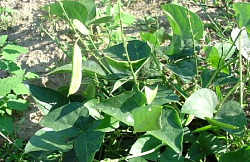 Lima Beans (Phaseolus lunatus) is a type of legume grown for their flat, crescent-oval-shaped seeds, which is eaten as a vegetable. It is popularly known as “Patani” in the Philippines. These highly nutritious beans are known by a number of alternate monikers, including Haba beans, sugar beans, butter beans, Guffin beans, civet beans, Hibbert beans, Pallar beans, Sieva beans, Madagascar beans, and Burma beans.
Lima Beans (Phaseolus lunatus) is a type of legume grown for their flat, crescent-oval-shaped seeds, which is eaten as a vegetable. It is popularly known as “Patani” in the Philippines. These highly nutritious beans are known by a number of alternate monikers, including Haba beans, sugar beans, butter beans, Guffin beans, civet beans, Hibbert beans, Pallar beans, Sieva beans, Madagascar beans, and Burma beans.
Limas are particularly sensitive to frost and cold soil and also more demanding of well-drained soil than other beans. Typically, lima beans are green to creamy white, with a starchy flavor that also has a hint of smooth richness. Most markets carry dried lima beans, and it is also possible to find canned lima beans in many shops. When the beans are in season, fresh lima beans can be found at some farmers’ markets, and they are certainly worth a try.
In cooking, lima beans can be used like other beans in a wide range of dishes including soups and stews. They can also be pureed to make a bean spread, or included in salads and chili. Lima beans pair well with a broad number of foods, and they are also enjoyable plain.
How to grow Lima Beans or Patani
Variations
There are two types of lima beans: bush and pole or vine varieties. Bush types grow to about 2 feet tall and tend to have smaller seeds; they bear more quickly than pole lima bean varieties. Pole lima beans have large seeds and can grow 10 to 12 feet high. Small-seeded limas, usually bush types, are also called butter beans, sieva beans, Burma beans, Madagascar beans, Carolina beans, and “baby limas.” Large-seeded lima beans are sometimes called potato limas. Large-seeded limas are often sold as dry beans. Lima beans have pale green pods that vary from 3 to 4 inches long to 5 to 8 inches long depending upon variety. Lima bean seeds are eaten, not the pods. Leaves are commonly composed of three leaflets and the flowers are white. Bush lima bean varieties are ready for harvest from 60 to 80 days from sowing; pole bean varieties are ready for harvest in 85 to 90 days.
Yield
Grow 4 to 8 lima bean plants per each household member.
Site
Grow lima beans in full sun; they will grow in partial shade but the harvest will not be full. Lima beans prefer loose, well-drained soil rich in organic matter. Beans prefer a soil pH of 6.0 to 6.8. Prepare planting beds in advance by working in plenty of aged compost. Avoid planting beans where soil nitrogen is high or where green manure crops have just grown; these beans will produce green foliage but few beans.

Planting Time
Lima beans are a tender annual that grow best in air temperatures between 60° and 70°F. Sow lima beans in the garden when the soil temperature has warmed to 65° or more for at least 5 days. For continuous harvest through the growing season, sow succession crop bush lima beans every two weeks or follow bush lima beans with long-maturing pole lima beans. Pole lima beans require a long growing period and are not a good choice where the season is short. Lima beans will not set pods in temperatures above 80°F or in cold or wet weather. Time your plantings to avoid hot weather. In mild-winter regions, lima beans can be sown in autumn for winter harvest.
Planting and Spacing
Sow lima beans 1½ to 2 inches deep. Plant bush lima beans 3 to 6 inches apart; set rows 24 to 30 inches apart. Plant pole lima beans 6 to 10 inches apart; set rows 30 to 36 inches apart. Set poles, stakes, or supports in place at planting time. Pole beans also can be planted in inverted hills–5 or 6 seeds to a hill; space hills 40 inches apart. Thin strong seedlings from 4 to 6 inches apart. Remove weaker seedlings by cutting them off at soil level with a scissors being careful not to disturb the roots of other seedlings. Bean can be crowded; they will use each other for support.
Water and Feeding
Grow lima beans in soil that is evenly moist and well drained. Bean seeds may crack and germinate poorly if the soil moisture is too high at sowing. Do not soak seeds in advance of planting or they may crack; do not over-water after sowing. Keep the soil evenly moist during flowering and pod formation. Rain or overhead irrigation during flowering can cause flowers and small pods to fall off. Once the soil temperature averages greater than 60°F, mulch to conserve moisture.
Lima Beans are best fertilized with aged garden compost; they do not require extra nitrogen. Lima Beans set up a mutual exchange with soil microorganisms called nitrogen-fixing bacteria which produce the soil nitrogen beans require. Avoid using green manures or nitrogen-rich fertilizers.
Companion Plants
- Bush beans: cucumbers, corn, cucumbers, celery, potatoes, summer savory.
- Pole beans: corn, scarlet runner beans, summer savory, sunflowers.
Note: Do not plant beans with onions, beets, or kohlrabi.
Care
Large lima bean seed may have trouble pushing through soil that has not been well worked; at sowing, cover the seeds with sand, vermiculite, or a peat moss-vermiculite mix instead. Cultivate around beans carefully to avoid disturbing the shallow root system. Do not handle beans when they are wet; this may spread fungus spores. Set poles, stakes, or trellises in place before planting pole beans. Select supports that are tall enough for the variety being grown. Rotate beans to plots where lettuce, squash, broccoli, Brussels sprouts, cabbage, cauliflower, or collards have grown in the past year or two.
Container Growing
Bush lima beans can be grown in containers, but you may need several containers for a practical harvest. Beans will grow in 8-inch containers.
Pests
Lima Beans can be attacked by aphids, bean beetles, flea beetles, leafhoppers and mites. Aphids, leafhoppers, and mites can be sprayed away with a blast of water from the hose or controlled with insecticidal soap. Look for eggs and infestations and crush them between your fingers and thumb. Pinch out and remove large infestations. Aphids can spread bean mosaic virus. Keep the garden clean and free of debris so that pests can not harbor or over-winter in the garden.
Diseases
Lima Beans are susceptible to blight, mosaic, and anthracnose. Plant disease-resistant varieties. Keep the garden clean and free of debris. Avoid handling plants when they are wet so as not to spread fungal spores. Removed diseased plants; put them in a paper bag and throw them away. Beans are susceptible to many soil-borne diseases; rotating beans so that they do not grow in the same location more than every three years will reduce soil-borne diseases.
Harvest
Bush lima beans will be ready for harvest 60 to 80 after sowing; pole beans will be ready for harvest 85 to 90 days after harvest. Pick lima beans when pods are plump and firm. Continue to pick pods as soon as they become plump to extend flowering and the production of new pods. When seeds mature, the plant will die. Pods left too long will result in seeds that are tough and mealy. Bush lima beans should produce 2 or 3 pickings in a season.
Storing and Preserving
Unshelled lima beans will keep in the refrigerator for one week. Shelled lima beans can be blanched and frozen for up to 3 months. Dried shelled limas can be stored in a cool, dry place for 10 to 12 months.
Source: www.harvestwizard.com, www.hort.purdue.edu; Photos: Wikipedia.org, www.organicgardeninfo.com